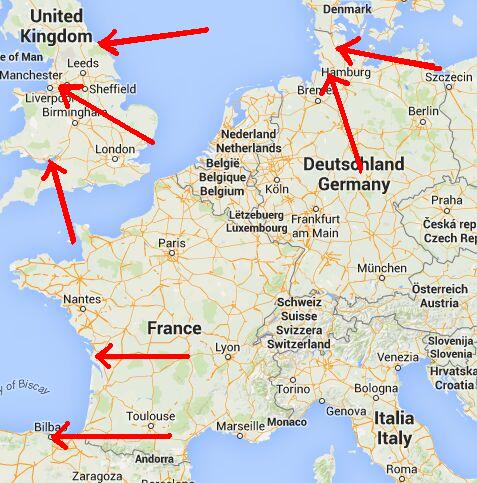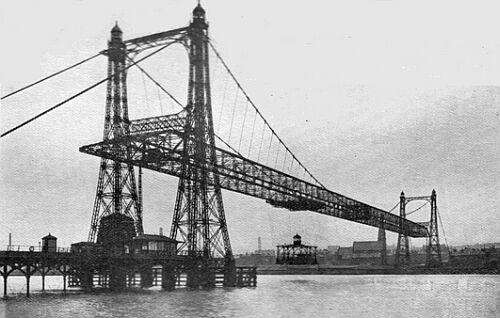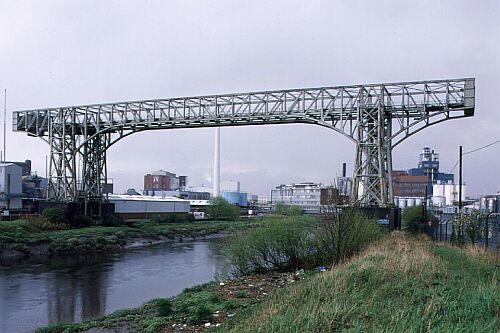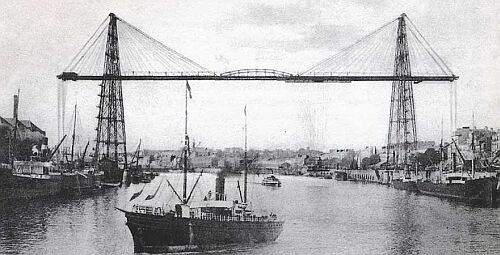Today an transporter bridge would not be constructed anymore. There are good alternatives available in order to traverse a large water. Consider the construction of a tunnel, a high bridge, a modern motorboat, or a modern barge that serves as a ferry.
For over 100 years ago this was different. The making of a tunnel was technically still very difficult. And creating a bridge was a difficult and costly. Especially there when there is a port or river where seagoing vessels must pass the location. A ship can be quite high, and in order to make a high bridge, there is also the need for long ramps in order to reach suffecient height. For a ferry there was actually only one way of moving, to say a steam engine. That was an expensive thing, both in purchase and in operation. Motorboats were not yet in use in that century. And a cable ferry with manual control (as in small rivers could be used) was for a large water of course not possible.
Below you find a map of Europe, on which seven of the eight transporter bridges of today are listed (number eight is in Argentinia).

The location of transporter bridges which are in use nowadays.
The next large transporter bridges are in use on this moment.
| Place | Date built | Length | Vertical clearance height |
|---|---|---|---|
| Rendsburg (Du) | 1913 | 135 m | 41 m |
| Osten (Du) | 1909 | 80 m | 30 m |
| Rochefort (Fr) | 1900 | 140 m | 50 m |
| Bilbao (Sp) | 1893 | 161 m | 45 m |
| Warrington (GB) | 1916 | 57 m | 23 m |
| Middlesbrough (GB) | 1911 | 173 m | 49 m |
| Newport (GB) | 1906 | 196 m | 54 m |
| Buenos Aires (Arg) | 1914 | 65 m | ? m |
Last years there have been introduced some small, modern transporter bridges
| Place | Date built | Length | Vertical clearance height |
|---|---|---|---|
| Mönchengladbach (Du) | 2003 | 8 m | 4 m |
| Müngstener Brücke (Du) | ? | ? m | ? m |
The core of a transporter bridge is formed by a bridge built over the river. But in contrast to normal bridges there is no need for ramps leading to the bridge. The bridge structure can be exactly as long as the width of the water.
Such a bridge is composed of a portal structure held upright by struts or by tension cables, and surmounted by a horizontal construction. For those horizontal construction there are three possible forms:
As a suspension bridge. A relatively simple construction, often consisting of a steel construction. This will be hold by vertical wires which are attached to cables which are tensioned between the two portals. this construction is the as that of a suspension bridge, with the difference, that the bridge part of a transporter bridge can be lighter, and that the bridge portion is located at a high altitude. And of course, there are no ramps needed to bring the road to the desired height.

Good examples of this construction can be found in Rochefort, Newport and Runcorn.
Made as a steel construction which is built all over the river. This is the same principle as a normal bridge, but with the difference that the structure at an transporter bridge can be lighter, and that there are no ramps needed to bring the road to the desired height.

Good examples of this construction can be found in Rendsburg and Warrington.
Designed as two independent columns with horizontal construction. These pillars are then held in place with tension cables. Between these two pillars there is an independent construction (like a normal bridge) that is hanged between the two pillars.

Good examples of this construction can be found in Marseille and Nantes.
In the horizontal structure there are running rails, on which can ride a cart. On this cart there hangs a platform hold on cables or by a steel construction. The height of the platform is at approximately the height of the shore. Such a platform looks very much like a ferry, but with the difference that it does not float in the water, but in the air some meters above water level. On the platform there is a barrier which is opened when the platform is on the shore.
The propulsion of the trolley on top of the horizontal construction was often with a simple electric motor, although in the start time there were also constructions with a steam engine. For the propulsion there was not requiered much energy. A boat or a rolling construction has resistance. The only resistance of a transporter bridge consists of the rolling resistance of the trolley.
This page is part of the Websites of Wim Kusee